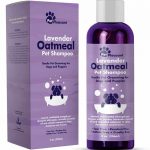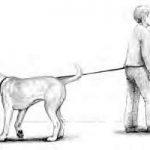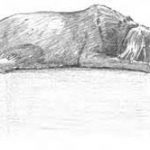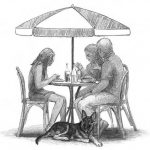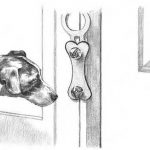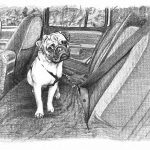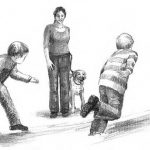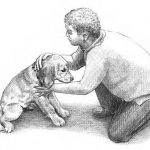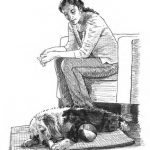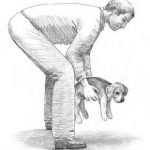Preventative and Emergency Care

In This Chapter
- Keeping your puppy healthy with daily care, grooming, and regular checkups
- Relieving your puppy’s allergies
- Getting your puppy spayed or neutered
- Treating your pup in emergencies
In this chapter, I cover everything from how to gussy up your puppy to how to prevent illness through daily maintenance. Prevention really is worth a pound of cure. I also address how to handle emergencies and how to do CPR and artificial respiration on your puppy. Hopefully you won’t need this information, but do read it over just in case. Knowing how to handle situations from cuts and burns to skeletal injuries can save your pup’s life.
Staying on Top of Good Hygiene and Health
Making bath time lots of fun
Tip
Here’s a way to prevent this scenario of having your dog bolt during bath time: Make “Tub” a direction and practice tub exercises long before you give your puppy a bath. The trick works so well that your puppy may start jumping into the tub on command. Use the following steps:
1. Say “Tub,” run to the tub, and treat your puppy (without actually putting him in). Repeat often.
2. Next, lay a towel on the bottom of the tub for traction, place some toys around it, and rub a tasty spread (like peanut butter) onto the basin at your puppy’s nose level to keep him content and occupied.
You’re doing a practice run without water.
3. Help your puppy into the tub, play for five minutes, and then take him out.
While sitting on the tub’s edge, love on him and treat him calmly. Remember that at this step you have no bath and no water.
4. Repeat Step 3 until your puppy looks forward to tub togetherness.
5. Next, run the water as you’re playing but let it drain (don’t fill the tub).
6. After your puppy allows the water to run while he’s in the tub, let the tub fill to hock (ankle) depth.
If your dog squirms, stop the water, sing softly, and offer some treats as you scratch his back lovingly.
7. Proceed gradually until you’re able to fill the tub and bathe peacefully (see Figure 20-1).
Remember
Stick with one bath a month at the most. The reason? Dogs don’t have pores to produce oil. If you bathe them constantly, their coats become dry, dull, brittle, and full of dandruff.
Brushing made easy
Tip
Following are some suggestions to make your puppy’s first associations with grooming pleasant ones:
– Use a soft-bristle human or puppy brush. You can eventually work toward using the brush of your choice, but for now, avoid the wirebristled brush. Also keep in mind that as your puppy matures, he’ll shed his puppy coat and will require a more sophisticated brushing tool. To discover which brush is best for your pup’s needs, speak to a groomer or pet-store professional.
– Spread peanut butter or chicken broth in your puppy’s food bowl or provide a delectable chew for distraction. Show your puppy the seasoned bowl when he’s in a quiet mood, and as he enjoys the diversion, softly draw the brush over his body.
Warning!
If your puppy growls fiercely at any point while you’re brushing him, stop everything and call a professional right away.
Performing daily care and spot-checks
Remember
Any mindful puppy owner knows that a puppy can’t articulate discomfort or dismay. Establishing daily routine checkups not only conditions your puppy to handling but also keeps you aware of anything that runs amiss.
Eyes
Tip
If your veterinarian prescribes eye medication, administer it carefully by swiping something tasty on the refrigerator (peanut butter or broth) at a 30-degree angle above your dog’s eye level. Stand behind your dog or to his side and pull back the upper lid until you see the white of your dog’s eye; carefully drop in the medication.
Ears
– Clean the outer ear flap. Ask your veterinarian to recommend a commercial ear solution that helps prevent infection. Using a cotton ball soaked in the solution, swipe the outer flap. Use caution when cleaning because the ear is very tender and going in too deep can be painful. Repeat this process until the cotton comes up clean.
Warning!
Don’t use cotton swabs or poke into your puppy’s ear canal. You can cause irreparable damage by doing so.
– Prevent water from entering the ear. If you’re bathing your pup, put a cotton ball in the opening ahead of time and wipe the ears out with a dry cotton ball when you’re finished.
Remember
Ear infections are quite common. Signs of infection include a red or swollen ear, discharge, head shaking, ear itching, or bad odor. If you notice any of these symptoms, get your puppy to his doctor immediately. Left untreated, infections can cause fever, depression, irritability, and loss of balance. Your veterinarian may prescribe an ointment that you administer at home. Here’s how to use it:
1. Wait until your dog’s a little sleepy.
2. Bring him to the refrigerator and swipe some peanut butter or broth at his eye level.
3. As he’s licking the refrigerator, gently squeeze the amount of ointment specified by your veterinarian into his ear canal.
4. Massage his ear as you praise him warmly.
Taking your puppy’s temperatureNow here’s a fun activity your whole family will enjoy. Okay, maybe not. With all the technological improvements of late, your puppy will still have to endure the old thermometer-in-thebottom style of preventative care. It’s best to occupy his mouth with something tasty (peanut butter or treats top my dog Whoopsie’s list) while you dip a rectal thermometer in petroleum jelly and slide it in. The time varies on the individual thermometer: Read the instructions for use. Note that a resting dog’s temperature is between 100.5 degrees and 102.5 degrees, which is much warmer than the 98.6-degree normal for humans. A good idea is to take your puppy’s temperature when he’s well so you can gauge an illness when symptoms show. |
Nose
Remember
Dogs’ noses can become discolored. One potential cause is the sun. When your puppy hangs in the sun, protect his nose with a sunblock with an SPF of 45. Another reason a pup’s nose may become discolored is an allergic reaction to a plastic food dish or household detergent. In such cases, use stainless-steel bowls for your dog’s dishes, and clean with environmentally safe products.
Mouth
– Include dry food in your puppy’s diet. The saliva involved in chewing kibble helps clean your puppy’s teeth.
– Start brushing your puppy’s teeth once a week. Use special dog toothpaste instead of human toothpaste because fluoride and dogs don’t mix. If your dog is adverse to the brush, use your finger or a finger brush. If your dog growls at you, quit immediately and call a professional.
Tip
If you have a young puppy, acquaint him with this procedure early on. Rub your fingers along his gums throughout the week and praise him calmly as you brush.
– As your dog gets older, you may opt for professional cleaning. To clean your dog’s teeth, your veterinarian needs to anesthetize him. Then she scales each tooth separately and finishes with polishing.
Nails
Tip
The best kind of clipper looks like a guillotine. Seriously. I can’t explain it any better than that. This clipper is ideal because it isolates the nail and steadies your cut. Ask your veterinarian or groomer or pet-store employee about this tool.
1. Initially, just handle your puppy’s paws — nothing fancy.
If you’re in the car and come to a red light, turn to your puppy, handle his paws, and tell him “Good boy.” Have as much hand-on-paw contact as possible for a week or two. Perform no clipping at this step.
2. Next, take out your peanut butter (or broth) and swipe some across the refrigerator at your dog’s eye level. As he licks, rub his paws with the clipper.
Don’t cut the nails just yet. Open and shut the clippers to acquaint him with the sound.
3. Now try one cut — just one. Place the edge of the clippers over the top of the nail and squeeze the handle quickly.
White nails show the nail bed, which you must avoid. If your puppy has dark nails, you need to take extra precaution. If you’re concerned, ask your veterinarian or groomer to give you a lesson.
4. The next day, try two nails and then three.
Remember
Don’t correct your dog if he protests. Be understanding and slow down. Again, nail clipping sounds like a production, but in the long run, you’ll be glad you took the time to do it right. Anyone who has cut her dog or frightened him by being too rough can tell you that having a clipper-phobic dog is a nightmare.
Warning!
God forbid you cut into your puppy’s quick (the tissue part of the nail). Aside from being excruciatingly painful, the cut will bleed for hours because the quick has lots of veins. To prevent excess bleeding, purchase a clotting solution like styptic powder from your veterinarian. It works like magic.
An Apple a Day: Taking Your Pup for Regular Checkups
Warning!
Vaccines aren’t guaranteed 100 percent. Some dogs are allergic to them. In others, antibodies don’t build up enough of a defense. Postvaccine illnesses are tragic. Keep your puppy at the animal hospital for 30 minutes after he receives his initial vaccines, and find out the signs and symptoms of each illness so you can recognize them.
Achoo! Dealing with Allergies
Tip
Here’s a checklist to follow if you suspect your puppy suffers from allergies, noting all seasonal and environmental changes:
– Use detergent soap designed for babies’ diapers when washing your puppy’s bedding.
– Check out the sprays used in your home, yard, and garden. Don’t use any products toxic to your pet. Imidacloprid and fipronil are nontoxic.
– Because many dogs are allergic to commercial disinfectants, use bleach and water (1⁄4 cup of bleach per gallon of water) to clean your dog’s areas.
– Don’t overuse cleaning or parasite products. Flea sprays, powders, and dips can be very toxic.
Remember
Many dogs also have or over time acquire food allergies. Corn and wheat are common culprits, but your puppy may also be sensitive to the base meat in his food. If you suspect a food allergy, speak to your veterinarian. She’ll likely suggest a dietary change and may want to narrow your pup’s diet fundamentally to pinpoint the cause.
Spaying or Neutering Your Puppy
– According to the book titled The Adoption Option (Howell), approximately 4 million to 6 million dogs are euthanized in animal shelters each year. Don’t add to the problem. If you’re not breeding your dog responsibly, have him or her altered.
– Having your dog fixed reduces the chance of breast, ovarian, uterine, and cervical cancer in females and testicular cancer and prostate infection in males.
– Male dogs are less likely to mark your home or fight with other male dogs and are more likely to stay close to home when they’re neutered.
Remember
If you adopt your puppy from a shelter, you may be required to neuter him. Some shelters offer to do the procedure for you, and others direct you to a low-cost facility. Altering can cost anywhere from $50 to $250, depending on the individual dog’s sex and health.
Accidents Happen: Preventing and Treating Puppy Mishaps
Knowing how to puppy proof your home
Remember
Try to prevent as many emergencies as possible by puppy proofing your home and restricting your puppy’s freedom to enclosed or puppy-proofed environments.
Hunting for household dangers
Tip
Prevent lamp-cord electrocution! Tape all cords hanging 4 feet from the ground to the wall, and pin floor cords to the baseboard. Also, keep a bottle of Bitter Apple spray handy, and each time you see your puppy nosing a wire, spray it immediately.
Taking care of small indigestibles
Keeping poison control numbers on hand
Remember
You can call the 24-hour National Animal Poison Control Center if your puppy has swallowed something poisonous: 900-680-0000. (Because this is a 900 number, your phone bill will be charged or they will ask for a credit card. However, their immediate and professional assistance is worth a pot of gold when your puppy is in distress!) Keep the label of the ingested matter on hand or describe what was swallowed; the operator is trained to talk you through the incident, translate symptoms, and tell you exactly how to handle each incident.
Avoiding poisonous plants
Warning!
If your puppy is carrying a plant in his mouth, don’t race toward him. If you do, he perceives your actions as prize envy and may gulp the evidence. Approach calmly and stare at the floor, not into his eyes.
Puppy first aid 101: Knowing the basics
Restraining a hurt pup
Remember
Even the most beloved pet may bite when he’s in pain or confused. If he doesn’t bite you, he may go for the vet or one of the technicians, so restrain your puppy for their sakes. The simplest restraining technique requires a bandana or a rope (the bandana is more comfortable).
1. Fold a bandana into a long band.
2. Drape the center of the band across the top of your dog’s nose.
3. Cross the two ends underneath your dog’s chin.
4. Tie the ends securely behind your dog’s ears.
5. Check the crossing point underneath.
If the crossing point is too loose, your dog may paw it off; if it’s too tight, you may choke him.
Transporting a hurt pup
Tip
Be ready for an emergency anytime by having a dog-sized board in your home or garage.
Remember
Puppies can’t articulate pain. They can’t intellectualize it, meditate on it, or separate themselves from it. Pain is pain. It’s an intense feeling and a state of being. Pain puts dogs in a vulnerable state. It confuses their thought process and their physical organization. Their only drive is to protect themselves and alleviate their distress. Add that state of mind to your puppy’s natural temperament, and what you get is a fairly unpredictable reaction. Though dogs experience pain in the same way, they deal with it differently.
Helping a choking pup
1. Bring your puppy into a standing position, even if someone must hold him there.
2. Try to reach in and dislodge the object.
Warning!
Be careful — you could jam the object in farther or get bitten if your dog’s panicking.
3. If you can’t dislodge the object, try a modified version of the Heimlich maneuver.
If your puppy is able to stand, clasp your hands together underneath him and pull up into his abdomen — just behind the sternum. Repeat this action five times vigorously.
If he’s unable to stand or is wiggling, steady him into an upright position and continue as described before.
4. If all else fails, get your dog to the veterinarian immediately.
Performing artificial respiration and CPR
Remember
As horrible as it is to see your puppy lying there after a fire or a car accident or after choking, ingesting poison, or being electrocuted, it may not be too late to save him. So be quick, stay calm, and think clearly when performing the following steps for performing artificial respiration:
1. Check for a heartbeat and breathing.
If your pup’s heart is beating but he isn’t breathing, proceed to the next step. If you also don’t feel a pulse, see the instructions that follow for administering CPR.
2. Check for any obstructions in the mouth and clear his mouth of any blood or mucus.
3. Pull his tongue out to make sure the airway is clear.
4. Shut his mouth gently.
5. Pull his lips over his mouth and secure them by wrapping one hand under his chin.
For breeds that have pushed-in noses, wrap your mouth around the nose.
6. Create an airtight funnel to his nose with your free hand.
7. Inhale, and then exhale air smoothly into your puppy’s nose.
8. Repeat every five to six seconds.
1. If you have a large pup, lay him on his right side. If you have a small pup, place a hand on either side of his chest.
2. Compress the heart area of the chest in short bursts, one compression per second.
3. Exercise one breath every six seconds.
You’ll know when you’ve saved your dog because he’ll come back to life.
Stopping your pup’s bleeding
– The everyday cut and scrape: This injury is no big deal. Twice a day, wipe the area with hydrogen peroxide to keep it safe from infection, and it should heal just fine.
– A continuous or oozing stream: This type of bleeding requires medical attention immediately. Raise the body part above the heart if possible and apply bandages one on top of the other to soak the blood as you press down on the area to slow the flow.
– A gushing spurt and flow: This type of bleeding is serious — very serious. Your puppy can go into shock quickly and die if he loses too much blood. Place bandage on top of bandage, elevate the limb if possible, and put constant pressure on the incoming artery. Drive to the nearest animal hospital.
Warning!
If you suspect internal bleeding, get your puppy to a hospital immediately. Internal bleeding is a life-threatening situation. White gums, a distended abdomen, a bloody cough, or vomiting spells are indications of internal bleeding.
Tip
Find your puppy’s pressure points. While he’s sleeping, feel for the pulse near the hip and elbow joints. These arteries regulate blood flow, and in an emergency, you can press them to slow it down. You can also use ice packs to slow the flow of blood from oozing cuts and scrapes.
Treating bug bites and stings
Warning!
A severely allergic dog goes into respiratory failure, which can be fatal within minutes. This reaction is called anaphylaxis and requires immediate veterinary attention. If you know your puppy is sensitive to insect bites, ask your veterinarian to prescribe a bee sting kit that can counteract the reaction in an emergency.
Treating snake bites
– Most native North American snakes that are solid colored or have stripes running the length of the body are nonvenomous.
– Be careful of snakes with diamond backs, stripes running around the body, or those with blotch patterns. In North America, poisonous snakes include rattlesnakes, water moccasins, cottonmouths, coral snakes, and copperheads.
Remember
If your puppy is bitten by a poisonous snake, get him to his veterinarian immediately, phoning her as you’re en route so that she may prepare an antidote.
Treating burns
– Take your puppy to a quiet area and calm him.
– Steadily pour cool water over the area. If it’s a chemical burn, continue to pour water on the burn for five to ten minutes.
– If the burn is superficial, keep it clean and rub it with an antibacterial ointment twice a day. More-serious burns demand immediate medical attention.
Tip
If your puppy gets burned by chewing on electrical cords and is in pain, apply ice to the burns and give him ice water. Then take him to his veterinarian, who may prescribe antibiotic oral gel to prevent infection and may recommend a dietary change until his mouth is back to normal.
Treating and preventing heatstroke
Remember
Heatstroke is preventable. Never leave your puppy in a poorly ventilated environment, and make sure water is always available on warm days. If an emergency necessitates leaving your puppy in the car, contain him in a kennel or seat-belt harness and leave the car running with the air conditioning on and doors locked. For cases like these, keep an extra set of keys in the glove compartment to take with you so you can get back in your locked car.



